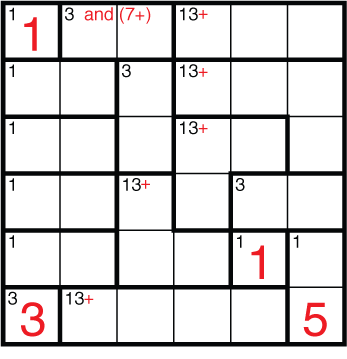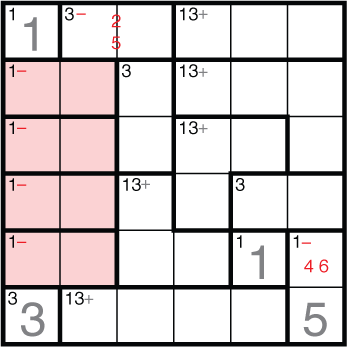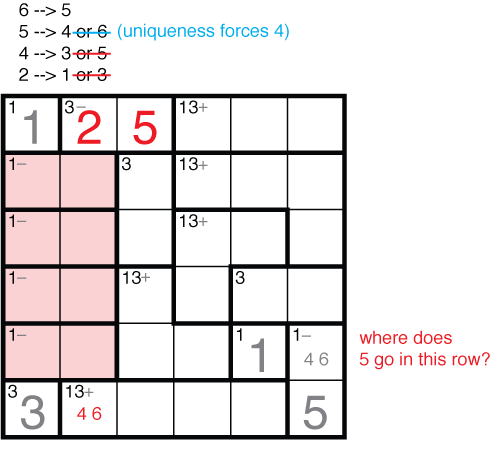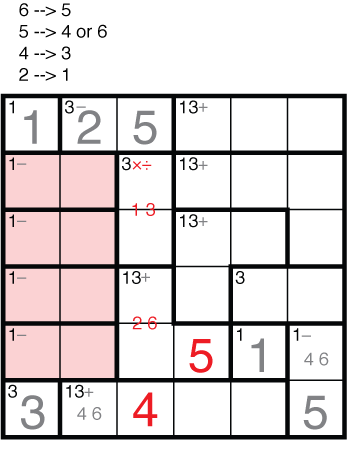Ask Dr. Sudoku #1 – That 1/3/13 TomTom?
First in a series with puzzle solving tips. This time, TomTom solving tips for last week’s hard Thursday puzzle.
People always ask me how to solve puzzles and fast. My first answer is practice, practice, practice! My second is notation, notation, notation! After that, I say learn how to construct interesting puzzles and run through more involved logical deductions than most puzzles tend to have. In this column I intend to dissect some of our Grandmaster Puzzles with such interesting properties and at the same time reveal ways I look at puzzle styles that might help out in the future. This week’s topic is the Thursday TomTom, advertised at medium-hard difficulty, that few solvers beat in an expected time. While it shouldn’t need saying, SPOILERS AHEAD!
“Basic” TomTom global steps, specifically that the total sum is 21 for all rows in a 6×6 puzzle, should get the solver to this position. Also, while this is a NoOp puzzle, all the 13’s are clearly + cages.

A similar early observation is to see that all two-cell 1 cages are subtractions (try to think of a counter-example). In fact, this NoOp puzzle is turned effectively into an Op puzzle very quickly. Only three 3 cages have any flexibility, the top one is resolved quickly, and the other two can be resolved much later in the solve.
The key to this puzzle is to consider the unusual grouping of four 1- cages on the left side collectively.

The 4 left cell entries in the subtraction cages are 6, 5, 4, and 2. Each of these entries needs a partner in column 2, one digit away. So these can be 5, 4 or 6, 3 or 5, and 1 or 3 respectively. But if 6 becomes 5, then 4 cannot also become 5 in the second column. 4 becomes 3, and from similar logic 2 becomes 1. The 5 can be either a 4 or a 6 (for logic I will consider both options). But uniqueness arguments force 5 to go to 4. If not, then a 65 and 56 which are completely interchangeable exist in the left of the puzzle giving 2 solutions.
An alternate way to see this without diagramming all the sets is to consider parity. If the two numbers not in the four 1- cages in the leftmost column are odd (1 and 3), the two numbers not in the four 1- cages in the second column are even. In the 25 at the top, the 2 must be to the left.
(Aside: “Uniqueness” — making a deduction because the consequence of any other possibility is to have more than one solution — is a useful concept for speed solving but typically frowned on from a standpoint of mathematical rigor because such steps do not conclusively prove there is just one answer. I’d say they “feel bad” as a solver, almost like cheating. Not cheating in the “Eugene” sense, but maybe cheating oneself out of a better experience. Still, sometimes discovering them is an unexpected Aha moment and that is what many people commented on with this puzzle, getting a 6 in R6C2 much sooner by doing so. Why did they feel comfortable using uniqueness here? Well, I know how to write valid puzzles. Grandmaster Puzzles only have 1 answer (free t-shirt to anyone who first reports a mistake on this front), so this is a special and trusted puzzle setting where uniqueness probably feels even worse to use but will always get the right job done quicker.)

Identifying the sets in the first two columns places a 2 in R1C2, and a 4 or 6 in R6C2. Critically, it also puts a 5 into column 3 at the top. Now, the key row is the second from the bottom. Where can the 5 go in this row? If it is in columns 1 or 2, it drags in a 4 and a 6 in one way or another (one is in the other column 1/2 cell, the other in column 6). That leaves 2 and 3 in the three-cell 13+ cage so cannot work. Instead there must be a 5 in R5C4 and the puzzle solves in a more standard way from there. Note that uniqueness is not needed at all; quickly after placing the 5 in R5C4 you get a 4 in R6C3 that resolves the 4/6 question.

I hope this is a revealing look at what is a quite unusual TomTom. While our puzzles may get hard, there is always an interesting logical route and the discovery process will be worth persevering through. So use uniqueness, (or even worse “guess”) at the risk of compromising your own enjoyment! Some get joy from solving puzzles very fast. Others from solving very good puzzles. Some from both. Choose your own path through these Grandmaster Puzzles.

Nice talk! Thank you!
Dear Dr.Sudoku,
If one day, puzzles and sudoku can become popular more than chess, will you still giving tips or puzzles freely? I think your experience is priceless in this field..
Thanks Thomas!
I actually chose a different digit in the “where does the 5 go” step in my solve. I actually chose, “where does the 2 go in Row 5”. It can’t be in R5C1, as 2-1 isn’t possible in the 1- cage, so this means it has to be in the 13+ cage, which means that cage is 256, and then the 3 only can go in R5C2.
It’s pretty similar, but i feel it’s a bit nicer than the “that leaves 2 and 3 in the 13+ cage” logic.
Perfectly good rationale. You can get the 256 in there quickly before the column thinking and then also a three in the left for a slightly different path. My reason to focus on the five is not because it is the easiest step but because my puzzle solving intuition says place a 5, think about other 5s. I recommend such focusing for speed.
I can see why. I think I had that 256 before working out that 25 placement at the top, as I went directly from the 2 in C1 has to be in a 21 to seeing, then the 2 can’t be in Row 5 there. I work far more on cages than on specific digits in Killer Sudoku/Tomtom which is why if there’s a sneaky hidden single in a puzzle that’s important I might get caught up in them.
Nice Walkthrough!hitting the nail right on the head!melting the weakest link of the chain.Text book stuff of solving puzzles…I was no way close to doing by the way in which you have explained motris..i remember distinctly that 5 in the lower right corner in my solving came a bit later..Took me some time to realise how you immediately wrote at the start..the 13 sum! beautiful…i can see the sticking points in my solve clearly///////
I’m really glad I’m going back through these original puzzles and posts, (during the current break in publishing of daily puzzles). This walkthrough really helped me realize why my solution took me so interminably long on this puzzle. Very well written, Thomas.
Thanks!